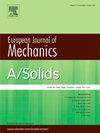Determination of material constants of piezoceramics using genetic algorithm
IF 4.4
2区 工程技术
Q1 MECHANICS
引用次数: 0
Abstract
This study seeks to accurately determine the piezoelectric material constants of piezoceramic disks from the resonant frequencies of the disks using a genetic algorithm programmed according to the principles of plate theory. Mindlin's plate theory is judged to be most suitable for approximating the relationship between the in-plane and out-of-plane resonant frequencies and the material constants of a disk-shaped piezoceramic thick plate, which was programmed into a genetic algorithm in order to obtain all relevant piezoelectric material constants from measured resonant frequencies of sample piezoceramic disks through inverse calculation. To verify the accuracy of the material constants, finite element method was employed to derive the theoretical resonant frequencies along with the corresponding mode shapes, which were then compared with the actual resonant frequencies measured using amplitude-fluctuation electronic speckle pattern interferometry. The comparison shows that the genetic algorithm can successfully determine all desired material constants of piezoceramic disks from the measured resonant frequencies in a single operation, and that the resonant frequency values modeled using the constants more accurately correspond to the experimentally measured frequencies than those derived from material constants obtained using conventional methods.
利用遗传算法确定压电陶瓷的材料常数
本研究试图利用根据平板理论原理编程的遗传算法,从压电陶瓷圆盘的谐振频率准确确定其压电材料常数。根据判断,Mindlin 的平板理论最适合用于近似计算盘形压电陶瓷厚板的平面内和平面外谐振频率与材料常数之间的关系,因此将该理论编程到遗传算法中,以便通过逆计算从测量的样本压电陶瓷盘谐振频率中获得所有相关的压电材料常数。为验证材料常数的准确性,采用有限元法推导出理论共振频率和相应的模态振型,然后将其与使用振幅波动电子斑点图干涉仪测量的实际共振频率进行比较。比较结果表明,遗传算法可以在一次操作中根据测量到的共振频率成功确定压电陶瓷盘的所有所需材料常数,而且与使用传统方法获得的材料常数相比,使用这些常数建模的共振频率值更准确地对应于实验测量频率。
本文章由计算机程序翻译,如有差异,请以英文原文为准。
求助全文
约1分钟内获得全文
求助全文
来源期刊
CiteScore
7.00
自引率
7.30%
发文量
275
审稿时长
48 days
期刊介绍:
The European Journal of Mechanics endash; A/Solids continues to publish articles in English in all areas of Solid Mechanics from the physical and mathematical basis to materials engineering, technological applications and methods of modern computational mechanics, both pure and applied research.

 求助内容:
求助内容: 应助结果提醒方式:
应助结果提醒方式:


